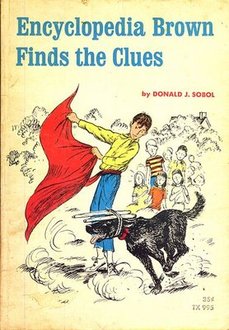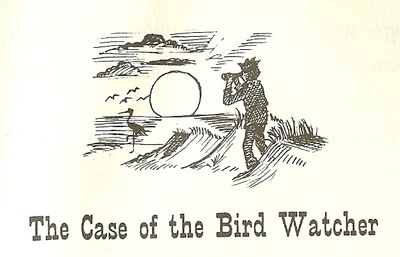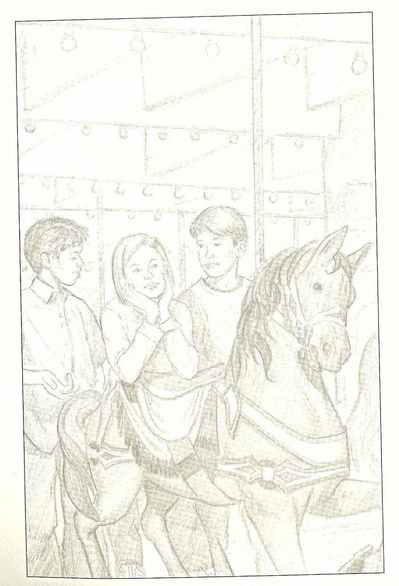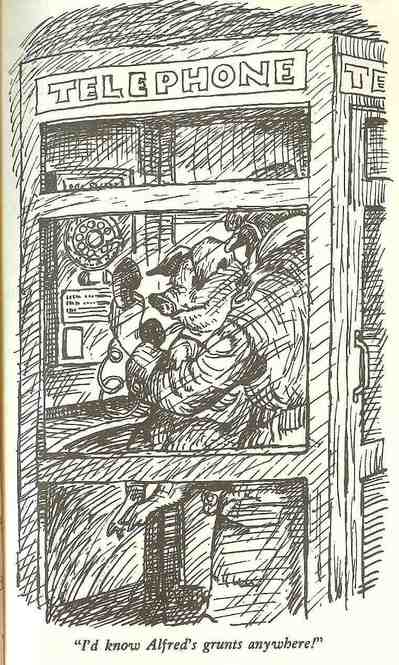The 10 Most Ridiculously Difficult Encyclopedia Brown Mysteries
 |
By Bryan Hartzheim
The quiet town of Idaville seems friendly and idyllic at first glance, but underneath that suburban fa?ade is a seedy underbelly of petty criminals: thieves, swindlers, and bullies, all compulsive liars, and all hiding behind public reputations that mask their evil intentions. If not for the crime-solving abilities of Encyclopedia Brown — the nerdiest superhero of them all — Idaville would have the highest crime rate in the nation and thugs like Bugs Meany, for example, would evolve into the rapists and murderers they’re so naturally predisposed to becoming. Of course, Encyclopedia’s ability to solve mysteries frequently borders on the absurd due to author Donald Sobol’s clear disregard for his readers’ self-esteem (many of whom have ended their lives prematurely from being unable to crack these “children’s stories”) and temporality (many of these mysteries just haven’t aged well since they were written back in the ’70s and ’80s). These 10 cases are the best representations of Sobol’s hell-bent desire to frustrate the hell out of sons and daughters and their seemingly more intelligent parents.
10) The Case of the Civil War Sword from Encyclopedia Brown: Boy Detective
CASE: Young Peter has a chance to trade his bicycle for a real Civil War sword used by General Stonewall Jackson, but the owners’ of said sword are none other than the dreaded Tigers’ clubhouse. Peter enlists Encyclopedia’s help in determining if the sword is really Gen. Jackson’s. Tigers’ leader Bugs Meany tells Encyclopedia that the sword is from the first Battle of Bull Run, and an inscription on the sword says as much: “Presented to [Jackson] by his men on August 21, 1861.” From this, Encyclopedia knows that the sword is a fake.
SOLUTION: Only Northerners called the battle by the name “Bull Run.” Jackson’s men, being Southerners, would have called the battle by its Southern name, “Manassas.” Of course, the sword also says, “The First Battle of Bull Run,” and since the second battle was in 1862, no man living in 1861 would have known there would be a second battle the following year. But most children don’t even know what the Civil War is other than media depictions in westerns or Looney Tunes where the Yankees are assholes (and still are). And even the few children who can tell the Civil War from the American Revolution certainly don’t display an Apu-like knowledge of its major motives, battles, and dates.
9) The Case of the Roman Numeral Robber from Encyclopedia Brown and the Case of the Slippery Salamander
CASE: Mr. von Martin’s jewelry shop has been robbed by the Roman Numeral Robber, who leaves notes behind written in Roman Numerals (as opposed to Aramic). When Encyclopedia arrives, the shop is dark and musty, with a copy of the paper, an unopened can of soda, and a bag of pretzels near the cash register. His classmates Charlie Stewart and Herb Stein are there with him. There is a broken window towards the rear of the store, and near it, a note: “June XXIIII, Dear Mr. von Martin: Say good-bye forever to your precious von Martin watch. I am sure that it will bring me a small fortune when I sell it!” Not much to go by, but from these clues alone, Encyclopedia has enough to determine the identity of the thief when the police arrive.
SOLUTION: The note, which has a “IIII” as opposed to a “IV” written on it for the date, June 24. Jewelers often write “IIII” instead of “IV” when designing watches, meaning the culprit was thus Mr. von Martin. The various paraphernalia and mise-en-scene comprising the rest of the store are simply Sobol’s sick red herrings. This is an impossible case for children since most have big digital watches that are waterproof. On the other hand, the adults reading this who own these nicer watches are furiously opening them up and checking for the “IIII” mark right now. And not finding them. Sobol, you’re a jerk.
8) The Case of the Missing Watch Goose from Encyclopedia Brown Takes the Cake
CASE: Candida Strong (in what is the first uncomfortable incorporation of a minority character into the largely Anglo-Saxon world of EB), enlists Encyclopedia’s help in finding her missing goose, Chris Columbus Day, in the nearby forest. They find a few white feathers and ask a group of campers if they’ve seen a goose, only to be rebuffed that the feathers are from chickens. The two come up on another group of campers giggling by a campfire who offer them both platters of freshly roasted chicken and dripping dark breast meat.
SOLUTION: Chicken breast is only white, and all goose meat is dark. Therefore, the campers were eating the goose. Other than the fact that most children or adults don’t eat geese – aside from their fattened and delicious livers – and thus would never know that their breast meat is any darker or lighter than a chicken’s, would you really try to challenge a group of isolated strangers who have just proven that they can slaughter and cook a goose, and then lie to innocent children about it? Is that not the worst real-life Deliverance red-flag imaginable?
7) The Case of the Umpire’s Error from Encyclopedia Brown and the Case of the Slippery Salamander
CASE: The Idaville Indians are about to play the Pittfield Porpoises, but the umpire can’t make it to the game due to car trouble. One of the Porpoise parents, a computer salesman, volunteers to ump the game after declaring he was an umpire in the majors for three years. He immediately begins to make unfavorable calls towards the Indians (it is always implied that the children of Idaville learn their lying ways through their parents). When the ump dusts off the plate, some of the parents start hurling insults. At that point, when Encyclopedia reads the back of the ump’s shirt with the message, “Don’t go wrong when you buy a Krumm computer,” that he realizes the ump is a fraud.
SOLUTION: If you thought there was something to do with computers here, well, that’s exactly what Sobol wanted you to think (he’s a jerk!). Encyclopedia’s “proof”: umpires are trained to face the crowd when they dust off the plate in the majors, where it’s considered bad manners to show your back to the crowd. But wouldn’t the ump more simply just not give a shit about this crowd, especially when they’ve been insulting him all game?
6) The Case of the Bird Watcher from Encyclopedia Brown Saves the Day
CASE: Someone sends the boy detective a letter enclosed with 25 cents to meet at Mr. Dunning’s gas station at sunrise the next day. Encyclopedia shows up, but no one is there. Back at his garage, Chief Brown shows up with Bugs Meany, who says he saw Encyclopedia letting the air out of Mr. Dunning’s truck tires. Encyclopedia confirms he was there. Bugs, on the other hand, states he was bird watching in the morning. Walking along the shore of the Dade River which runs east to the ocean, he could definitely see Mr. Dunning’s truck as he claimed. He even names four different birds that come to the river at that time as proof for his alibi.
SOLUTION: Bugs, yearning to get back at Encyclopedia after years of intellectual emasculation, is trying to frame him. A real bird-watcher never walks east early in the morning; walking into the rising sun, he would only see the birds as dark shapes against the bright sky. Walking into the west, the sun’s full light would come behind him and fall on the birds. Bugs had sent the letter and let the air out of the tires himself. To solve this one, a child would have to either be a bird-watcher (unlikely) or inclined to wake up before sunrise (impossible).
—-
5) The Case of the Black Horse from Encyclopedia Brown and the Case of The Jumping Frogs
CASE: Stinky Redmond has just stolen Waldo Emerson’s essay while on a carousel, but Emerson (there is no transcendentalist connection, but the essay argues for the flatness of the world) obtains the services of Encyclopedia Brown to get it back. Stinky says that he had been riding on the black horse with a foot off the ground, but he got sick since it kept going up and down and he had to get off the carousel. He then sat on the bench where Waldo’s bag was lying, but claims he didn’t take the essay inside. Waldo, on a white horse which was three horses in front of Stinky’s, claims that he never saw Stinky on the carousel, and that when the ride ended all he witnessed was Stinky running like mad from the bench.
SOLUTION: In not so thinly-veiled racism, the criminal here is the black horse. Or rather, the rider of the black horse. Or rather, the person who said he rode the black horse. Because Stinky could not have been going “up and down” on the black horse since, with three feet on the ground, it’s designed not to move at all. Everyone knows that only carousel horses with all feet in the air move up and down! And by everyone, I mean any kids who actually gives a shit about what the horse is doing other than looker fierce or fancy on a merry-go-ride.
4) The Case of Lathrop’s Hobby from Encyclopedia Brown and the Case of the Treasure Hunt
CASE: Tommy and Paul have stolen a sheet of Lathrop’s prized toilet paper (don’t ask) and Encyclopedia comes in to investigate. Tommy accuses Paul of hiding the TP in the garage; Paul says he saw Tommy folding something in the bathroom. They first search the garage. Encyclopedia looks through a pile of wood chips and paint cans by a vise on the workbench. Tommy and Paul watch each other as they search the shelves. Lathrop goes through the garden tools. Not finding the TP, they then check the bathroom, and find three pills in the wastebasket. They open the medicine cabinet, take down a silver pillbox, and find the TP folded in half eight times inside. Paul’s accusation is seemingly validated.
SOLUTION: Tommy is innocent, since you can’t fold anything in half more than seven times. Paul clearly used the vice in the garage to fold the TP to hide in the pillbox to blame Tommy. Of course! Using a cumbersome vice to fold a minuscule piece of paper in half an eighth time (while your friends patiently wait for you in the other room) makes so much more sense than hiding it in a book or under a rock. Or simply putting it in your pants and walking out of there. And why would toilet paper be a more lucrative object of theft than, say, jewelry or cash?
3) The Case of the Glass of Ginger Ale from Encyclopedia Brown and the Case of the Secret Pitch
CASE: The blind violinist Rafino de Verona has just had his prized Stradivarius swindled by the dastardly concert master Hans Braun, who bets de Verona that he can enter the room, open a locked safe, take out a glass, remove the ice, pour into the glass a bottle of ginger ale, lock the safe, leave the room, and lock the door behind him, all without de Verona hearing him. De Verona, who prides himself on his ability to pick up even the quietest of sounds, accepts the challenge, but Braun, who prides himself in the less noble field of locked room puzzles, wins the bet when de Verona innocently opens the safe an hour later and finds the glass filled with ginger ale.
SOLUTION: Braun is crafty enough to blinker a blind man, but not the brilliant Encyclopedia, who determines that Braun had snuck in an insulated bag which keeps ice from melting, made innocuous comments to cover up the sound of the opening of the insulated bag, and then placed his own ice – made from ginger ale – into the glass instead of ice cubes made of water. Hans Braun never opened the safe, and the ice simply melted into ginger ale, which even the bat-like de Verona would not have been able to hear. In this Columbo-like mystery, no child knows what an insulated bag is, let alone that it prevents ice from melting. And even this is a patent lie; unless the bag is made of dry ice, the ice will only last marginally longer than if it was placed in a thermos, allowing Sobol yet another way to make America’s children feel stupid.
2) The Case of the Window Dressers from Encyclopedia Brown Lends a Hand
CASE: In one of the most bizarre books ever written by Sobol, a carnival of freaks has apparently descended on Idaville, creating mysteries for runaway elephants, exploding toilets, and “skunk apes.” But the most outrageous mystery is this one Hector’s department store. A group of four women walk by the detectives with a papier-mache bull. Two men carrying bullfighters costumes walk by, along with a large color poster of a bullfight. Three more men walk by holding plastic figures with female clothes, and bringing up the rear is a man holding several petticoats and a woman with a clothesbrush, saying the whole brigade are going to dress windows for a display of female toreador pants (all the rage in Idaville these days). Minutes later, gunshots are heard and the jewelry department has been robbed, but young Sally Kimball, Encyclopedia’s pretty, non-sexual, and illogically powerful female companion, knows who the robbers are.
SOLUTION: The last two. But how? Well, petticoats are worn under skirts, not under pants, so the man carrying the petticoats was not really a window dresser, and instead scooped them up from a store counter to hide his gun; while he fired the shots, his partner grabbed the jewelry. Sally brags to Encyclopedia that he would never know this since he’s a boy (and this is true); but would most girls even know this? Would most southern belles know this? Yes. Would most of middle America under 30 know this? Maybe (as you can see, most of these cases are educations in American Life for godless city folk). Would Asian children learning to read know this? No. But they’d learn what a petticoat is.
1) The Case of the Kidnapped Pigs from Encyclopedia Brown Saves the Day
CASE: Lucy Fibbs and Carl Benton’s pigs have been kidnapped to prevent them from winning the Idaville pet show, and Encyclopedia has been hired to investigate. Carl received a phone call that said the pigs would be returned after the show unharmed, but then the caller had to hang up because he ran out of dimes, so he gave Carl his number (ZA6-7575) to call him back. In an illogical conclusion, the caller is determined to be a child because a grown-up would have more money. The key suspects are the Hurricanes; one of their hats was left at the scene of the crime. Encyclopedia questions the Hurricanes, whose dogs are in direct competition with the pigs. Encyclopedia asks each of the members if they lost a cap. Harry (Hurricane?) says they all wear the same size, but says he hasn’t worn his cap in a week; Flip says his is in the front closet and he wore it two days ago when it rained. Art says he loaned his cap to his brother, who went to Glenn City on Tuesday. Merle threatens to punch Encyclopedia. Everybody glares at Encyclopedia. Encyclopedia leaves. The pigs remain missing.
SOLUTION: Carl kidnapped the pigs, wanting to knock Lucy out of competition. Just before the pet show, he would have released his pig, Alfred, and claimed it escaped the kidnapper’s clutches. Carl lied about the phone call since no phone dial has a letter Z. I’d bet you’re looking at your cell phones now to find that Z. It’s there, right under the 9. This case would only apply to those who possess very old dial or rotary phones without Zs on them, and that is simply impossible to solve today since all children over four possess cell phones. There isn’t even a charm here like in some of Sherlock Holmes’ dated cases where silencers were unheard of, and hands couldn’t be checked for gunpowder residue, letting murderers simply place guns into the hands of the murdered for apparent suicides. Those were the days…
